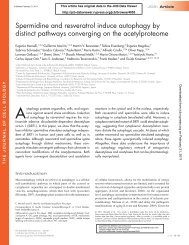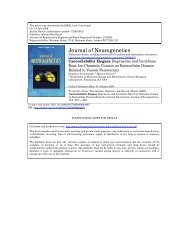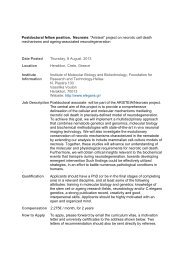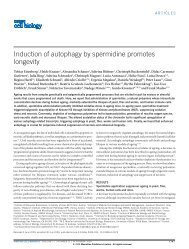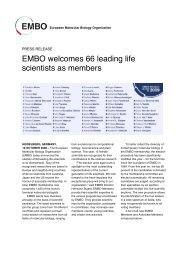CELL BIOLOGY OF THE NEURON Polarity ... - Tavernarakis Lab
CELL BIOLOGY OF THE NEURON Polarity ... - Tavernarakis Lab
CELL BIOLOGY OF THE NEURON Polarity ... - Tavernarakis Lab
Create successful ePaper yourself
Turn your PDF publications into a flip-book with our unique Google optimized e-Paper software.
Cell Biology of the Neuron: <strong>Polarity</strong>, Plasticity and Regeneration, Crete 2011<br />
Otx2-glycosaminoglycan interactions for Otx2 transfer<br />
in the visual cortex<br />
Clémence Bernard, Julien Spatazza, Ariel Di Nardo and Alain Prochiantz<br />
CNRS UMR 7233, Collège de France, Paris, France<br />
Otx2 homeoprotein activates a critical period during which the visual cortex is<br />
plastic. This signalling requires an activity-dependent intercellular transfer, as<br />
Otx2 is not expressed in the visual cortex. We have shown that during postnatal<br />
development, Otx2 is transferred specifically into parvalbumin (PV) GABAergic<br />
interneurons and induces their maturation.<br />
The specific internalization of Otx2 by PV-cells led us to study whether<br />
glycosaminoglycans (GAG) present at the surface of PV cells, called perineuronal<br />
nets (PNNs), are involved in Otx2 recognition. We find that PNN hydrolysis by a<br />
chondroitinase, which reopens ocular dominance plasticity in adulthood, reduces<br />
the number of Otx2-positive cells in the visual cortex. A consensus GAG-binding<br />
motif containing an arginine-lysis (RK) doublet has been identified within Otx2<br />
primary sequence. This motif has a high affinity for chondroitin sulfates,<br />
antagonizes Otx2 specific internalization by PV cells in vivo, and reopens a<br />
window of plasticity in the adult visual cortex. These results are not observed<br />
when the RK doublet is replaced by 2 alanines.<br />
We introduced this RK→AA mutation in a transgenic knock-in Otx2-AA mouse.<br />
The preliminary immunohistochemical studies of these mice suggest that this<br />
mutation disrupts the interaction between Otx2 and PNNs and impacts visual<br />
circuits development. Indeed, in these mice, we observed dose-dependent changes<br />
of PV and PNN staining intensity, which suggests a defect in PV interneuron<br />
maturation. This will be confirmed by an electrophysiological study of these<br />
Otx2-AA mice.<br />
Presented by: Bernard, Clémence<br />
93<br />
Poster No 011<br />
Green Session



